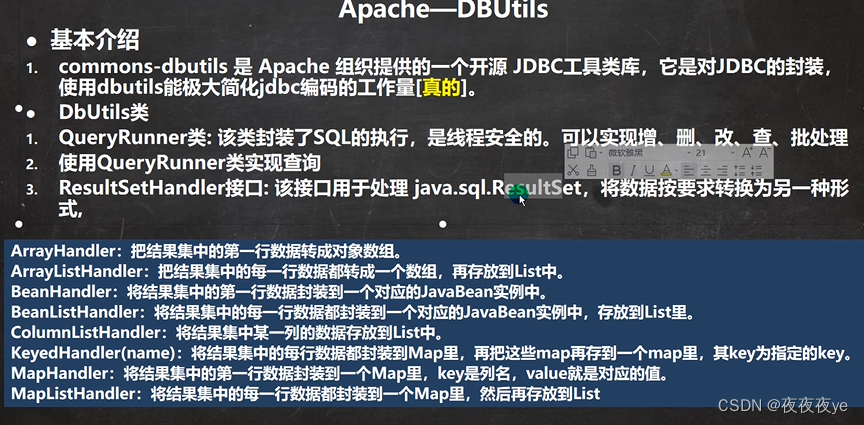JDBC程序编写步骤:
1.注册驱动,加载driver类
2.获取连接得到connection
3.执行增删改查,发送sql给mysql执行(Preparestatemennt)
4.释放资源关闭连接
public class Jdbc01 {
public static void main(String[] args) throws SQLException {
//在项目下创建一个文件夹比如libs
//将mysql.jar拷贝到该目录下,点击add to project
//1.注册驱动
Driver driver = new Driver();
//2.得到连接
String url = "jdbc:mysql://localhost:3306/db03?characterEncoding=utf8";
//将用户名和密码放入到Properties 对象
Properties properties = new Properties();
properties.setProperty("user","root");//用户
properties.setProperty("password","123456");//密码
Connection connect = driver.connect(url, properties);
//3.执行sql
String sql = "insert into actor values(null,'刘德华','男','1970-11-11','110')";
//String sql = "update actor set name='周星驰'where id = 1";
//用于执行静态SQL语句并返回其生成的结果的对象
Statement statement = connect.createStatement();
int row = statement.executeUpdate(sql);//如果是dml语句,返回的是影响的行数
System.out.println(row>0? "成功":"失败");
//4.关闭连接
statement.close();
connect.close();
}
}
连接数据库五种方式
1.上述方式
2.使用反射连接
//使用反射加载Driver类
Class<?> aClass = Class.forName("com.mysql.jdbc.Driver");
Driver driver = (Driver)aClass.newInstance();
//得到连接
String url = "jdbc:mysql://localhost:3306/db03?characterEncoding=utf8";
//将用户名和密码放入到Properties 对象
Properties properties = new Properties();
properties.setProperty("user","root");//用户
properties.setProperty("password","123456");//密码
Connection connect = driver.connect(url, properties);
System.out.println("方式二"+connect);
3.使用driverManager替代driver进行统一管理
//使用反射类加载Driver
Class<?> aClass = Class.forName("com.mysql.jdbc.Driver");
Driver driver = (Driver)aClass.newInstance();
//创建url,user,passward
String url = "jdbc:mysql://localhost:3306/db03?characterEncoding=utf8";
String user = "root";
String password = "123456";
DriverManager.registerDriver(driver);//注册driver驱动
Connection connection = DriverManager.getConnection(url, user, password);
System.out.println("第三种方式"+connection);
4.使用class.forName自动完成注册驱动,简化代码
public void connect04() throws ClassNotFoundException, SQLException {
Class.forName("com.mysql.jdbc.Driver");
//创建url,user,passward
String url = "jdbc:mysql://localhost:3306/db03?characterEncoding=utf8";
String user = "root";
String password = "123456";
Connection connection = DriverManager.getConnection(url, user, password);
System.out.println("第四种范式"+connection);
}
5.使用配置文件
public void connect05() throws IOException, SQLException, ClassNotFoundException {
//通过properties对象获取配置文件的信息
Properties properties = new Properties();
properties.load(new FileInputStream("src\\mysql.properties"));
String user = properties.getProperty("user");
String password = properties.getProperty("password");
String driver = properties.getProperty("driver");
String url = properties.getProperty("url");
Class.forName(driver);//反射
Connection connection = DriverManager.getConnection(url, user, password);
System.out.println("第五种方式"+connection);
}
二.## ResultSet[结果集],表示数据库结果集的数据表,用于查询数据库的语句生成,resultSet对象保持一个光标指向当前的数据行,next方法将光标移向下一行
//用于执行静态SQL语句并返回其生成的结果的对象
Statement statement = connection.createStatement();
//组织sql
String sql = "select id,name,sex,borndate from actor";
//执行给定的sql语句,该语句返回单个的ResultSet对象
ResultSet resultSet = statement.executeQuery(sql);
//5.使用while取出数据
while (resultSet.next()) {
int id = resultSet.getInt(1);//获取该行的第一列
String name = resultSet.getString(2);
String sex = resultSet.getString(3);
Date date = resultSet.getDate(4);
System.out.println(id + "\t" + name + "\t" + sex + "\t" + date);
}
//6.关闭连接
resultSet.close();
statement.close();
connection.close();
三.## SQL注入:
statement存在sql注入问题,sql注入是指在用户输入数据中注入非法的sql语句段或者命令,用PreparStatement解决即可
Scanner scanner = new Scanner(System.in);
System.out.println("请输入名字和性别");
//让用户输入管理员和密码
String admin_name =scanner.nextLine();//看到注入效果用nextLine
String admin_sex =scanner.nextLine();
//通过properties对象获取配置文件的信息
Properties properties = new Properties();
properties.load(new FileInputStream("src\\mysql.properties"));
String user = properties.getProperty("user");
String password = properties.getProperty("password");
String driver = properties.getProperty("driver");
String url = properties.getProperty("url");
Class.forName(driver);//反射,注册驱动
Connection connection = DriverManager.getConnection(url, user, password);
//得到prepareStatement
//组织sql,Sql语句的?就相当于占位符
String sql = "select name,sex from actor where name = ? and sex= ?";
//prepareStatement对象实现了prepareStatement接口的实现类的对象
PreparedStatement preparedStatement = connection.prepareStatement(sql);
//给?赋值
preparedStatement.setString(1,admin_name);
preparedStatement.setString(2,admin_sex);
//执行用executeQuery,不要在里写sql
ResultSet resultSet = preparedStatement.executeQuery();
if (resultSet.next()){
System.out.println("登陆成功");
}else{
System.out.println("登录失败");
}
//关闭连接
resultSet.close();
preparedStatement.close();
connection.close();
四:## 事务

//操作转帐的业务
//1.得到连接
Connection connection = null;
//2.组织一个sql
String sql = "update account set balance= balance-100 where id = 1";
String sql2 = "update account set balance= balance+100 where id = 2";
PreparedStatement preparedStatement = null;
//创建PrepareStatement对象
try {
//建立连接
connection = JDBCUtils.getConnection();
//将connection设置为不自动提交
connection.setAutoCommit(false);
preparedStatement = connection.prepareStatement(sql);
preparedStatement.executeUpdate();//执行
preparedStatement = connection.prepareStatement(sql2);
preparedStatement.executeUpdate();//执行第二条
//这里提交事务
connection.commit();
} catch (SQLException e) {
System.out.println("执行发生了异常,撤销执行的sql");
connection.rollback();//默认回滚到事务开始
e.printStackTrace();
}finally{
JDBCUtils.close(null,preparedStatement,connection);
}
事务实例就是银行转账。
JDBC的批处理语句:prepareStatement.addBatch(),放在写出的语句后面,相当于加入语句
addBatch:添加需要批量处理的SQl语句和参数,executeBatch:用于执行批量处理语句,clearBatch:清空批处理包的语句
批量处理语句有效果需要在连接数据库的语句后面加上rewriteBatchedStatement=true
连接池
传统的连接不能连接太多,否则会崩溃

C3P0:
//1.创建一个数据源对象
ComboPooledDataSource comboPooledDataSource = new ComboPooledDataSource();
//2.通过配置文件获取相关的连接信息
Properties properties = new Properties();
properties.load(new FileInputStream("src\\mysql.properties"));
String user =properties.getProperty("user");
String password =properties.getProperty("password");
String url =properties.getProperty("url");
String driver =properties.getProperty("driver");
//给数据源comboPooledDataSource设置相关的参数
//注意连接管理由comboPooledDataSource来管理
comboPooledDataSource.setDriverClass(driver);
comboPooledDataSource.setJdbcUrl(url);
comboPooledDataSource.setUser(user);
comboPooledDataSource.setPassword(password);
//设置初始化连接数
comboPooledDataSource.setInitialPoolSize(10);
//设置最大连接数
comboPooledDataSource.setMaxPoolSize(50);
for (int i = 0; i <5000 ; i++) {
Connection connection = comboPooledDataSource.getConnection();//拿到连接
connection.close();
}
Connection connection = comboPooledDataSource.getConnection();//拿到连接
//System.out.println("连接成功");
}
//第二种方式,使用配置文件模板来完成
//将c3p0提供的c3p0.config.xml拷贝到src
public void testC3P0_02() throws SQLException {
ComboPooledDataSource comboPooledDataSource = new ComboPooledDataSource("hsp_edu");
Connection connection = comboPooledDataSource.getConnection();
connection.close();
}
德鲁伊连接:
public void testDruid() throws Exception {
//1.加入Druid jar包
//2.加入配置文件,将该文件拷贝到src目录
//创建properties对象读取配置文件
Properties properties = new Properties();
properties.load(new FileInputStream("src\\druid.properties"));
//4.创建一个指定参数的数据库连接池,德鲁伊连接池
DataSource dataSource = DruidDataSourceFactory.createDataSource(properties);
for (int i = 0; i <5000 ; i++) {
Connection connection = dataSource.getConnection();
//System.out.println("连接成功");
connection.close();
}
对其进行创造成工具:
```java
private static DataSource ds;
static {
Properties properties = new Properties();
try {
properties.load(new FileInputStream("src\\druid.properties"));
//创建连接池
ds = DruidDataSourceFactory.createDataSource(properties);
} catch (Exception e) {
e.printStackTrace();
}
}
//编写getConnection方法
public static Connection getConnection() throws SQLException {
return ds.getConnection();
}
public static void close(ResultSet resultset, Statement statement,Connection connection ) throws Exception{
if(resultset!=null){
resultset.close();
}
if(statement!=null){
statement.close();
}
if(connection!=null){
connection.close();
}
}
## ApDBUtils:将返回的结果集进行遍历,封装到一个集合中,传统的关闭了连接resulset结果集就无法使用了

```java
public class DBUtils_Use {
//使用apache-DBUtils工具类
public void testQueryMany() throws SQLException {
//1.得到连接(druid)
Connection connection = JDBCUtilsByDruid.getConnection();
//2.使用DBUtils类和接口,引入DBUTils相关的jar
//3.创建QueryRunner
QueryRunner queryRunner = new QueryRunner();
//4.执行相关的方法,返回ArrayList集合
//query方法就是执行sql语句,得到ResultSet,封装到ArrayList集合中
//new BeanListHandler<>(Actor.class)将Resultset->Actor对象->封装到Arraylist集合
//1就是给sql语句中的?进行赋值,可以有多个值
//如果返回的是单行记录,使用的是Beanhandler,返回的是对应的实体类
//返回单行单列用Scalarhande,返回的是Object
//底层得到的resultset,会在query关闭,关闭preparStatement
String sql ="select * from actor where id >=?";
List<Actor> list = queryRunner.query(connection,sql,new BeanListHandler<>(Actor.class),1);
for(Actor actor:list){
System.out.println(actor);
}
//释放资源
JDBCUtilsByDruid.close(null,null,connection);
}
}
执行修改语句update和插入insert和删除delete的代码:
String sql = "update actor set name =?where id=? ";
//执行dml操作的是queryRunner.update,返回的是受影响的行数
int affectedRow = queryRunner.update(connection,sql,"张三丰",4);
dao和增删改查通用方法-basicDao
方便快速查询
public class BasicDAO<T> {
private QueryRunner qr = new QueryRunner();
//开发通用的dml方法,针对任意的表
public int update(String sql,Object... parameters) throws Exception {
Connection connection =null;
try {
connection = JDBCUtilsByDruid.getConnection();
int update = qr.update(connection,sql,parameters);
return update;
} catch (SQLException e) {
throw new RuntimeException(e);//将一个编译异常转换为运行异常
} finally {
//关闭连接诶
JDBCUtilsByDruid.close(null,null,connection);
}
}
//返回多个对象,及查询的结果是多行
//Class<T> clazz传入的是一个类的class对象,比如Actor.class
public List<T> queryMulti(String sql,Class<T> clazz,Object...parameters) throws Exception {
Connection connection =null;
try {
connection = JDBCUtilsByDruid.getConnection();
return qr.query(connection,sql,new BeanListHandler<T>(clazz),parameters);
} catch (SQLException e) {
throw new RuntimeException(e);//将一个编译异常转换为运行异常
} finally {
//关闭连接诶
JDBCUtilsByDruid.close(null,null,connection);
}
}
//查询单行的结果的通用方法
public T querySingle(String sql,Class<T> clazz,Object...parameters) throws Exception {
Connection connection =null;
try {
connection = JDBCUtilsByDruid.getConnection();
return qr.query(connection,sql,new BeanHandler<T>(clazz),parameters);
} catch (SQLException e) {
throw new RuntimeException(e);//将一个编译异常转换为运行异常
} finally {
//关闭连接诶
JDBCUtilsByDruid.close(null,null,connection);
}
}
//查询单行单列的方法
public Object queryScalar(String sql,Object...parameters) throws Exception {
Connection connection =null;
try {
connection = JDBCUtilsByDruid.getConnection();
return qr.query(connection,sql,new ScalarHandler(),parameters);
} catch (SQLException e) {
throw new RuntimeException(e);//将一个编译异常转换为运行异常
} finally {
//关闭连接诶
JDBCUtilsByDruid.close(null,null,connection);
}
}
}
运用工具:
public class TestDAO {
//测试ActorDAO对actor表crud的操作
@Test
public void testActorDAO() throws Exception {
ActorDAO actorDAO = new ActorDAO();
//1.查询
List<Actor> actors = actorDAO.queryMulti("select *from actor where id >= ?", Actor.class, 1);
System.out.println("查询结果");
for(Actor actor:actors){
System.out.println(actor);
}
//查询单行记录
Actor actor = actorDAO.querySingle("select *from actor where id =?", Actor.class, 4);
System.out.println("查询的单行结果:"+actor);
//查询单行单列值
Object o = actorDAO.queryScalar("select name from actor where id = ?",6);
System.out.println(o);
}
}
























 被折叠的 条评论
为什么被折叠?
被折叠的 条评论
为什么被折叠?








